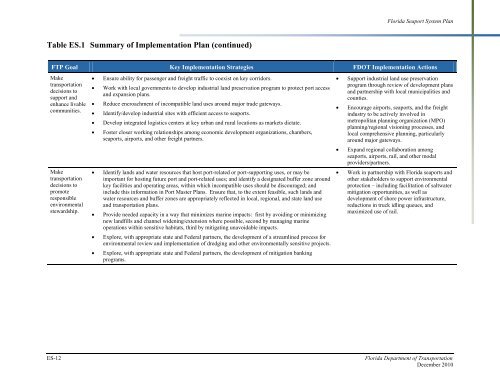Florida Seaport System Plan - SeaCIP
Florida Seaport System Plan - SeaCIP
Florida Seaport System Plan - SeaCIP
Create successful ePaper yourself
Turn your PDF publications into a flip-book with our unique Google optimized e-Paper software.
<strong>Florida</strong> <strong>Seaport</strong> <strong>System</strong> <strong>Plan</strong><br />
Table ES.1 Summary of Implementation <strong>Plan</strong> (continued)<br />
FTP Goal Key Implementation Strategies FDOT Implementation Actions<br />
Make<br />
transportation<br />
decisions to<br />
support and<br />
enhance livable<br />
communities.<br />
Make<br />
transportation<br />
decisions to<br />
promote<br />
responsible<br />
environmental<br />
stewardship.<br />
• Ensure ability for passenger and freight traffic to coexist on key corridors.<br />
• Work with local governments to develop industrial land preservation program to protect port access<br />
and expansion plans.<br />
• Reduce encroachment of incompatible land uses around major trade gateways.<br />
• Identify/develop industrial sites with efficient access to seaports.<br />
• Develop integrated logistics centers at key urban and rural locations as markets dictate.<br />
• Foster closer working relationships among economic development organizations, chambers,<br />
seaports, airports, and other freight partners.<br />
• Identify lands and water resources that host port-related or port-supporting uses, or may be<br />
important for hosting future port and port-related uses; and identify a designated buffer zone around<br />
key facilities and operating areas, within which incompatible uses should be discouraged; and<br />
include this information in Port Master <strong>Plan</strong>s. Ensure that, to the extent feasible, such lands and<br />
water resources and buffer zones are appropriately reflected in local, regional, and state land use<br />
and transportation plans.<br />
• Provide needed capacity in a way that minimizes marine impacts: first by avoiding or minimizing<br />
new landfills and channel widening/extension where possible, second by managing marine<br />
operations within sensitive habitats, third by mitigating unavoidable impacts.<br />
• Explore, with appropriate state and Federal partners, the development of a streamlined process for<br />
environmental review and implementation of dredging and other environmentally sensitive projects.<br />
• Explore, with appropriate state and Federal partners, the development of mitigation banking<br />
programs.<br />
• Support industrial land use preservation<br />
program through review of development plans<br />
and partnership with local municipalities and<br />
counties.<br />
• Encourage airports, seaports, and the freight<br />
industry to be actively involved in<br />
metropolitan planning organization (MPO)<br />
planning/regional visioning processes, and<br />
local comprehensive planning, particularly<br />
around major gateways.<br />
• Expand regional collaboration among<br />
seaports, airports, rail, and other modal<br />
providers/partners.<br />
• Work in partnership with <strong>Florida</strong> seaports and<br />
other stakeholders to support environmental<br />
protection – including facilitation of saltwater<br />
mitigation opportunities, as well as<br />
development of shore power infrastructure,<br />
reductions in truck idling queues, and<br />
maximized use of rail.<br />
ES-12<br />
<strong>Florida</strong> Department of Transportation<br />
December 2010
















